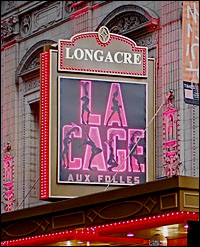
*
Ask Playbill.com answers your (and sometimes our own) theatre-related questions. To ask a question, email AskPlaybill@Playbill.com. Please specify how you would like your name displayed and please include the city in which you live.
Question: While some theatres are named after well-known historic and contemporary theatre persons, what is the story behind the Winter Garden, Cort, Belasco, Longacre, etc.? — Kay Josephs, Albuquerque, NM.
Answer: Because time continually marches on, and yesterday's famous Broadway personality become today's nonentity, some names of Broadway theatre become head-scratchers to the modern theatregoer. Only a few still reliably ring a bell: the Neil Simon Theatre, the Eugene O'Neill Theatre, the Richard Rodgers Theatre, the August Wilson Theatre and the Helen Hayes Theatre among them. Even more modern coinages require some explanation to those not conversant in Broadway history. For instance, the recently renamed Samuel J. Friedman Theatre honors a former press agent of note. And the Schoenfeld and Jacobs theatres are named after two powerful, recently departed Shubert Organization executives.
As the years go by, theatres are often renamed. The Wilson theatre moniker replaced the Virginia, which honored one-time owner Virginia McKnight Binger. But a few old-time theatrical biggies still grace marquees. Among these are the Belasco and Cort, which our curious reader, Kay, asked about. You are forgiven for not knowing who the Cort is named after. Few today recall John Cort. A former vaudeville performer, Cort moved into management in the 1890s. He rose to become the general manager of the Northwestern Theatrical Association, a theatre circuit centered in Seattle that once controlled 37 theatre in the west. (The Moore Theatre, still operating in Seattle, was once a Cort house.) He built the Cort Theatre in New York in 1912, and sold it to the Shuberts in 1927, two years before he died. That it's still named after him is something of a miracle. (It is, in fact, one of the few Broadway theatres never to have undergone a name change.) The Belasco, however, was named after a one-time theatrical god, and, if you don't know his name, you're not much of a student of theatre history. David Belasco was arguably the preeminent impresario of the 1900s and 1910s. He not only produced plays, but frequently directed and wrote them, and he nurtured and guided performers with a paternal and possessive care. He enjoyed the nickname "The Bishop of Broadway," because he affected a clerical outfit for reasons known only to himself. He is best known today for having written two plays that inspired eternal Puccini operas: Madame Butterfly and The Girl of the Golden West. The Belasco on West 44th Street, originally called the Stuyvesant, was actually the second theatre named after him. The first was on 42nd Street and is still there, under the name of the New Victory. His offices were above the 44th Street theatre and remain there, if in somewhat degraded form. (The Belasco is currently undergoing a renovation for a relighting in the fall, where the new musical Women on the Verge of a Nervous Breakdown will play.)
 |
||
| The Longacre Theatre |
The Winter Garden has been a popular theatre name for nearly two centuries. There was one for many years in London on the site now held by the New London Theatre. In 1850, New York got its first Winter Garden Theatre, at 624 Broadway opposite Bond Street. Junius Brutus Booth Jr., Edwin Booth and John Wilkes Booth staged a famous benefit performance of Shakespeare's Julius Caesar there in 1864. (Edwin managed the theatre for a time.) It burned down in 1867. There was a second Winter Garden Theatre at 1514-16 Broadway, which opened in 1895 as The Olympia Theatre. It was renamed several times and demolished in 1935. There is also an extant Winter Garden Theatre in Toronto.
The current Broadway Winter Garden playhouse is on land that was once home to the second American Horse Exchange, built by William K. Vanderbilt in 1896, when Longacre Square was the center of the horse and carriage trade. In 1911, when the Shuberts leased the Exchange, they converted the building into the Winter Garden Theatre.











